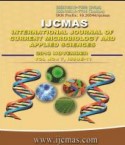


 National Academy of Agricultural Sciences (NAAS)
National Academy of Agricultural Sciences (NAAS)

|
PRINT ISSN : 2319-7692
Online ISSN : 2319-7706 Issues : 12 per year Publisher : Excellent Publishers Email : editorijcmas@gmail.com / submit@ijcmas.com Editor-in-chief: Dr.M.Prakash Index Copernicus ICV 2018: 95.39 NAAS RATING 2020: 5.38 |
Coriander is one of the first spices to be used by mankind dates back to 5000 BC. It is called as ‘Miraculous herb’ as all parts of the plant including seeds and leaves are used both as spice as well as herbal medicine. Among various diseases attacking coriander, stem gall disease caused by Protomyces macrospores Unger is the most devastating disease resulting 16-50 per cent yield loss. Considering the seriousness of this disease, present investigation was carried out on various aspects viz., survey, germplasm screening and integrated disease management at T.C.A., Dholi campus of Dr. Rajendra Prasad Central Agricultural University, Pusa, Bihar during 2015-2016 to 2017-18. Under disease management, after three years of experimentation (2015-16 to 2017-18), pooled analyzed mean data reveals lowest disease severity (PDI=12.22), highest disease reduction over control (79.40%), yield (2.26 t/ha) and yield increase over control (121.57%) in treatment where seed treatment was done with fungicide Propiconazole 25EC @0.20% followed by spraying at 45,60 & 75 days after sowing (DAS) @0.10%. 2nd lowest disease incidence (PDI=18.67) and 2nd highest disease reduction over control (68.53%) yield (2.02 t/ha) and yield increase over control (98.04%) were recorded in treatment T5 where Hexaconazole 5EC @0.20% was used for seed treatment & the crop was sprayed at 45, 60 & 75 DAS with same fungicide @0.10%. But the highest ICBR (1:10.69) was found in treatment T2, where seed treatment as well as spraying of crop at 45, 60 & 75 DAS was done with IISR Pseudomonas talc formulation @0.40% followed by ICBR of 1:10.32 was recorded in treatment T5, where seed treatment was done with Hexaconazole 5EC @0.20% and spraying of crop done at 45, 60 & 75 DAS was done with fungicide Hexaconazole 5EC @0.10%. The best treatment with respect to have its effect on highest disease reduction and giving highest yield registered 3rd best ICBR of (1:9.02). In control, highest PDI (59.33) and lowest yield (1.02 t/ha) was obtained.
 |
 |
 |
 |
 |